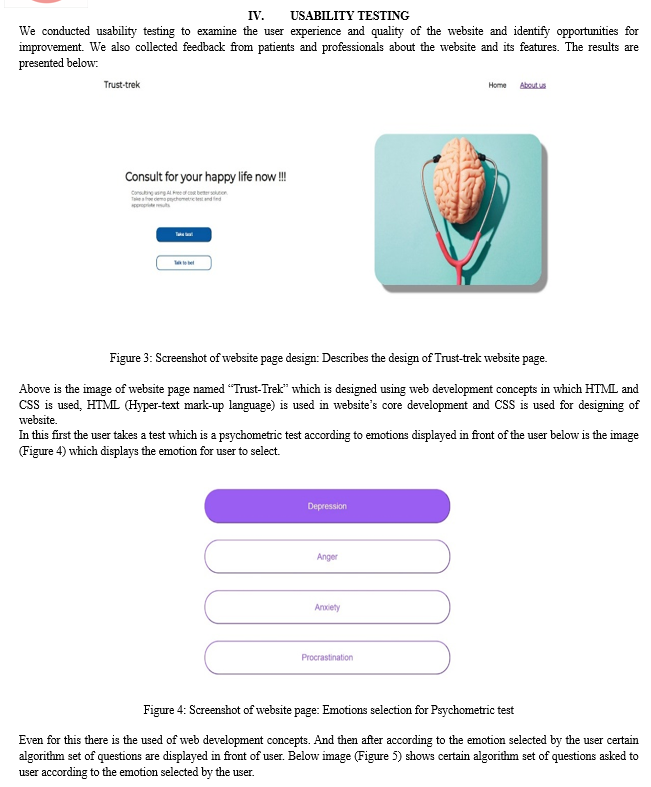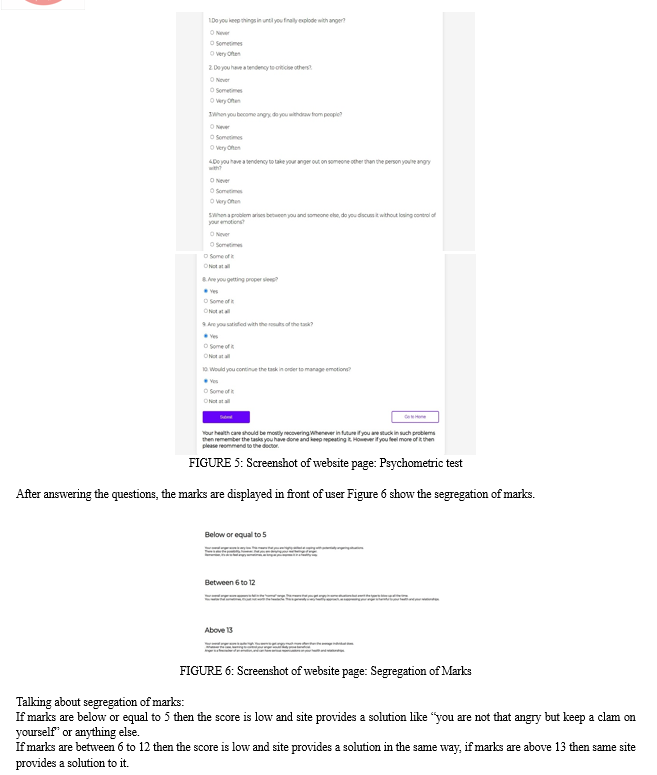Ijraset Journal For Research in Applied Science and Engineering Technology
- Home / Ijraset
- On This Page
- Abstract
- Introduction
- Conclusion
- References
- Copyright
Psychometric Test for Medical Consultancy System
Authors: Atharva Divekar, Om More, Shital Walujkar, S. A. Paithane
DOI Link: https://doi.org/10.22214/ijraset.2024.59702
Certificate: View Certificate
Abstract
Preliminary investigations delve into the possibility of employing chatbots in psychiatric therapy to aid behavior modification through assessments and chatbot interventions. Nevertheless, these platforms overlook the mental conditions of users, neglecting interviews, continuous surveillance, or ethical factors. We propose that enhancing emotion detection could boost user contentment among individuals seeking mental health assistance. Our suggestion encompasses an interactive psychiatric counseling service employing sophisticated natural language comprehension and multimodal emotion detection. This method permits ongoing and delicate observation of emotional fluctuations. Moreover, an instance-oriented reaction model, integrating moral discernment, facilitates suitable clinical reactions in psychiatric consultations.
Introduction
I. INTRODUCTION
For a long time, researchers have been examining how machines can comprehend human emotions. Recently, advancements in artificial intelligence (AI) have bolstered studies in this realm. In our investigation, we've educated diverse models to categorize emotions utilizing a substantial volume of labeled data. With technological advancement, we presently train these models using assorted data formats such as images, videos, audio, and text. Certain studies even merge multiple categorization models for enhanced accuracy through hybrid techniques. They've demonstrated encouraging outcomes in precisely identifying human emotions. Despite these strides, there are still restricted applications employing emotion recognition technology. Although intelligent assistant services are gaining traction, they're not extensively incorporated into major applications yet. Hence, there's a burgeoning interest in devising healthcare applications utilizing intelligent aides. Some chatbots and virtual assistants are already leaving a favorable impression on commercial and customer services.
However, numerous studies underscore the necessity for improved design of human-computer interactions to seamlessly integrate these systems into healthcare routines. To address this challenge, several research endeavors are concentrated on enhancing the efficiency of these systems through theory-based design, data visualization, and dispersed interfaces.
In the domain of computer science, endeavors are directed towards enhancing health, well-being, and healthcare, often referred to as e-Health. This entails employing technology to communicate with patients, furnishing them with health-related information sans conventional phone calls. Given the widespread accessibility of the internet, numerous applications have surfaced for this purpose. The categorization of e-Health applications varies, with one proposed classification focusing on the system's purpose, the technology employed, and its impact on public health.
The Oxford Experimental Psychology Department is recognized as one of the leading psychology departments in the UK. It showcases strong research groups covering various areas such as human cognitive functions, neuroscience, linguistics, developmental psychology, social psychology, and mental health disorders.
Psychology Today stands as one of the oldest platforms committed to behavioral science. Its objective is to delve into every aspect of human behavior, furnishing insights to empower individuals to manage their health and well-being, adapt their mindset, and navigate myriad mental health and relationship challenges.
In this manuscript, we present an application of Counselling chatbot, furnishing conversational assistance for mental health care.
II. LITERATURE REVIEW
- Researchers Ling lei, Jun Feng Li, and Wenrui Li carried out a study on "Evaluating the impact of artificial intelligence on mental health support for educators and students." The utilization of artificial intelligence in healthcare enhances illness diagnosis, categorization, and prognosis, providing advantages to both patients and healthcare practitioners.
- Authors Sanjay Chakraborty, Hrithik Paul, and Sayani Ghatak conducted an experiment on “ALGORITHM-based medical chatbot model for predicting infectious diseases.” Chatbots are very easy to use for everyone. This chatbot can be used in your language. The bot provides medical information such as doctor contact details, nearby hospital addresses, and contact details.
- Authors Gurpreet Singh, Bhavya Thotakura, Jeladurgam, Naveen Kumar Reddy conducted an experiment on “Online Health Consultation and Management System”. After searching around the world to find such a formal public health system, they decided to make a similar request to my country.
- Nivedita Bhirud and Subhash Tatale, the researchers, conducted a study on "Priority Index Based Organization of Residential Loads Using Intelligent Home Load Manager." It appears that there is a vast array of algorithms to execute all-Natural Language Understanding (NLU) and Machine Learning (ML) tasks. Selecting the appropriate algorithm relies on the capabilities offered by the chatbot and the area in which the service is offered.
- Authors Kyo-Joong, Dong Kun Lee conducted an experiment on “Chatbot for Psychiatric Consultation in Mental Health care''. Chatbots support psychiatric consultations in a conversational format. The service communicates with users through dialogue and provides psychiatric advice.

III. WORKING OF PROPOSED SYSTEM
A. There are Multiple Approaches
- Face-to-Face Counselling: This approach involves direct, in-person communication between the patient and the doctor. It allows for a personal connection
- Digital Intervention Counselling: This approach utilizes digital platforms for Counselling when face-to-face interaction is not possible. Patients can interact with doctors through video calls, chat, or other digital means, which can be convenient and accessible.
- Algorithm Psychometric Testing: In this method, algorithms are used to conduct psychometric tests on patients. These tests help in assessing the patient's mental health condition and categorizing it into basic or serious cases.
- Treatment Recommendation Process: If the algorithm determines that the patient's case is basic, it provides solutions or Counselling strategies. However, if the case is deemed serious, the ALGORITHM recommends the patient to consult a psychiatrist for further evaluation and treatment
B. The Comprehensive Explanation for each Operational Phase is Outlined Below
- Data Collection and Planning: This preliminary phase entails establishing objectives for the proposed application. We identified primary website participants/panels, including administrators.
- Development: The nucleus of the project is the creation of a web application. We opted for HTML (Hypertext Markup Language) and CSS (Cascading Style Sheets) for the design.
- Programming: The dynamic web application algorithms are employed to store, modify, and retrieve information inputted through various user interfaces.
- Evaluation, Assessment, Launch: Following the completion of the web application, it undergoes thorough testing to ensure its functionality. Subsequently, all system operation files, encompassing HTML, CSS, .NET, and other requisite files, will be uploaded to the cloud


Figure 2 describes Block Diagram of the system:
In the system first the user visits the website named “Trust-Trek” after coming over website. The user interacts with the interactive agent that is the user is asked to select with which problem the user is going through means different emotions are displayed in front of user like happiness, sadness, angriness, anxious and many more and according to that user selects the emotion.
Then certain set of questions are asked to user which are common questions related to the emotion selected by the user and such activity is known as Psychometric Test overall at first the user goes through a psychometric test in which certain common questions are asked to user related the emotion or the mental problem the user is going through.
After the psychometric test the site-based analysis is done according to answers answered by the user and those answers are sorted in 2 levels.
The site analysis is done and the answers are sorted in 2 levels:
a. Basic Problem
b. Critical Problem
If in the site analysis the answers answered by the user that is if through analysis the result/percentage of answers is below the result/percentage set by system then site sorts it as basic problem, if the user’s problem is a basic problem, then the site itself provides the solution to user like some activities are suggested to the user for example; Yoga, Walking or Jogging, Dancing, Cycling and many more.
Also, the system keeps a follow-up of the user following the activities given by the system/site and if the user is not satisfied with the given activity or is unable to complete the given activities, then the system updates the activity to the user.
If in the site analysis the answers answered by the user that is if through analysis the result/percentage of answers is equal or above the result/percentage set by system then site sorts it as critical problem, if the user’s problem is a critical problem, then the site suggest a near-by professional doctor or psychiatrics to the user so that the user meet the doctor for best therapy.
The block diagram represents the major components and their interconnections in the activity of mental health care system. It demonstrates how the user communicates with the site and site suggest some activities to user according to user’s psychometric test.



After the user engages with the site and asks for a solution to their problem, the site's chatbot provides the requested solution. Figure 7, illustrates the question posed by the user. Following the interaction with the chatbot, the website assigns tasks to the user.
Figure 8, displays the questions presented to the user as part of this task assignment process. This interactive feature enhances user engagement and facilitates the resolution of user queries or issues.
Conclusion
From this endeavor, create distinctive, dynamic, and adaptable software frameworks that integrate all medical system variables comprehensively. These platforms efficiently arrange all health metric discoveries. They can be employed by medical practitioners for assessment and generating valuable insights to improve decision-making.
References
[1] Lei, Ling, Jun Feng Li, and Wenrui Li. \"Scrutinizing the role of artificial intelligence in the mental healthcare of educators and students.\" Soft Computing (2023): 1-11. [2] Chakraborty, Sanjay, Hrithik Paul, Sayani Ghatak, Saroj Kumar Pandey, Ankit Kumar, Kamred Udham Singh, and Mohd Asif Shah. \"An AI-Based Medical Chat Agent Model for Infectious Disease Prediction.\" IEEE Access 10 (2022): 128469-128483. [3] Denecke, K., Vaaheesan, S. and Arulnathan, A., 2020. “An emotional well-being conversational bot for managing emotions (SERMO)-concept and usability test”. IEEE Transactions on Emerging Topics in Computing, 9(3), pp.1170-1182. [4] Polignano, Marco, Fedelucio Narducci, Andrea Iovine, Cataldo Musto, Marco De Gemmis, and Giovanni Semeraro. \"Health aide bot: A personalized health chatbot for the Italian language.\" IEEE Access 8 (2020): 107479-107497. [5] Ren, Xipei, Gabriele Spina, Simon De Vries, Annick Bijkerk, Babs Faber, and Anna Geraedts. \"Examining physicians’ encounters with conversational interfaces during work-related health consultations.\" IEEE Access 8 (2020): 119158-119169. [6] Oh, Kyo-Joong, Dongkun Lee, Byungsoo Ko, and Ho-Jin Choi. \"A dialogue agent for mental health counselling in mental healthcare service based on emotional conversation analysis and sentence generation.\" In 2017 18th IEEE international conference on mobile data management (MDM), pp. 371-375. IEEE, 2017. [7] Elmasri, Danielle, and Anthony Maeder. \"A conversational agent for an internet-based mental health intervention.\" In Brain Informatics and Health: International Conference, BIH 2016, Omaha, NE, USA, October 13-16, 2016 Proceedings, pp. 243-251. Springer International Publishing, 2016. [8] Mehfooz, Fahad, Sakshi Jha, Sahil Singh, Shreya Saini, and Nidhi Sharma. \"Medical chatbot for novel COVID-19.\" In ICT Analysis and Applications: Proceedings of ICT4SD 2020, Volume 2, pp. 423-430. Springer Singapore, 2021. [9] Koundinya, Hrushikesh, Ajay Krishna Palakurthi, Vaishnavi Putnala, and Ashok Kumar. \"Smart university chatbot using ML and python.\" In 2020 International Conference on System, Computation, Automation and Networking (ICSCAN), pp. 1-5. IEEE, 2020. [10] Bhirud, Nivedita, Subhash Tataale, Sayali Randive, and Shubham Nahar. \"An overview of literature on conversational agents in the healthcare sector.\" International journal of scientific &technology research 8, no. 7 (2019): 225-231.
Copyright
Copyright © 2024 Atharva Divekar, Om More, Shital Walujkar, S. A. Paithane. This is an open access article distributed under the Creative Commons Attribution License, which permits unrestricted use, distribution, and reproduction in any medium, provided the original work is properly cited.

Download Paper
Paper Id : IJRASET59702
Publish Date : 2024-04-01
ISSN : 2321-9653
Publisher Name : IJRASET
DOI Link : Click Here
 Submit Paper Online
Submit Paper Online

